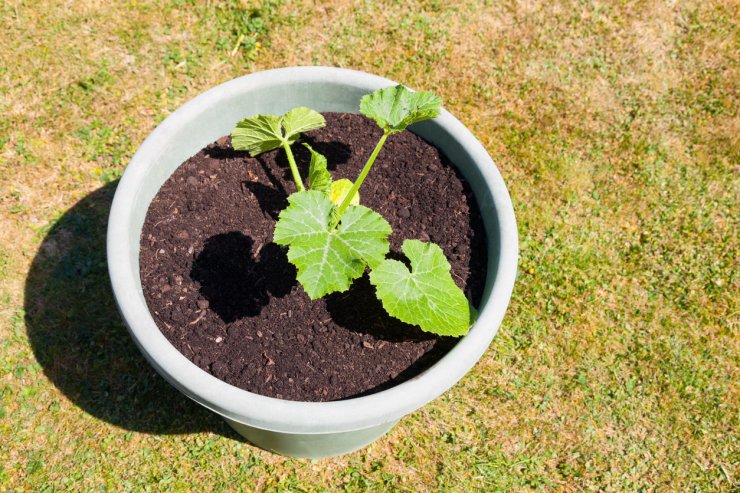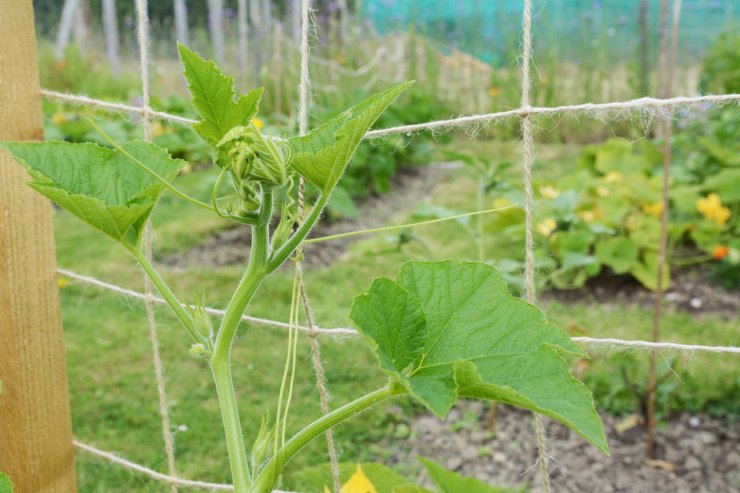
Young summer squash plant in large container.
As mentioned earlier, squash can be grown in containers, and you can add a trellis to a container or even an open-ground plant to save space and increase light and air circulation.
Two important components to successful container gardening are container size and soil type. Although it may not seem like it, one squash plant will fill a 24-inch pot in no time. The container should be at least 12 inches deep. Do not overcrowd squash plants!
Also, to promote drainage and prevent rot, drill several holes in the bottom of the container and place some fine gravel covered by a piece of wire mesh in the bottom of the container. This will keep the soil from clogging up the drainage holes.
Use a lightweight potting soil that contains ingredients like peat, compost, or fine bark. Try not to use regular garden soil, especially one that can easily become compacted and smother the root system. Also, soil from the garden could contain pests and weed seeds.
Plant a single starter, or plant two or three squash seeds near the center of the pot about an inch deep. Allow a couple of inches of space between each seed. Keep the soil slightly moist, but not soggy for the first week or two until the seeds germinate.
After two weeks, evaluate the seedlings. Remove the weaker seedlings and leave the strongest looking. Once the seeds sprout, reduce watering by waiting until the top 2 inches of soil dries out completely between watering.
Place (or move) your squash container in a location where it will get at least six or seven hours of full daily sun. Planting a few marigolds and nasturtiums with the squash will keep pests at bay.
Keep an eye on the moisture. Water when the soil is dry a couple inches down. Provide an organic fertilizer every two weeks during the growing season.
Adding a trellis

Curcurbit vine growing up trellis.
You can grow squash and other cucurbits on an A-shaped form or trellis. In a pot, you can even use a tomato cage if you have one handy. Otherwise, consider buying a ready-made trellis at the garden store, or building one of your own.
Smaller summer squash is ideal for growing on a trellis, as it won’t be too heavy for this method. Squash trellising can be as simple as crossing a couple of boards and threading some twine across to support the burgeoning vines.
The best summer squash varieties for squash trellising are zucchini and yellow summer squash. Some squash will require supplemental support in the form of tying and even fruit slings to prevent the developing fruit from pulling off the vine.
To build your own, you’ll need two vertical supports, such as strong wooden or metal posts, as your framework. Hammer the pieces in at an angle to each other in an A-shape. The bottoms of the posts must go deeply enough into the soil to help support a heavy plant laden with large fruit.
Space the posts 5 or 6 feet apart. You can also brace these posts with a cross angle at the base and across the middle. Growing squash on trellises requires a sturdy foundation as the fruit will weigh heavily on the posts. For larger squash, use a three-post system for better stability.
As the squash grows, select three to five healthy vines to grow on and prune off peripheral growth. Build a framework of wire spaced at least 5 inches apart on the poles. Tie the vines as they get bigger along the wires to help support the plant.
As fruit develops, use fruit slings to cradle them and prevent the weight from pulling the developing squash off the vine. Believe it or not, old pantyhose or another stretchy piece of fabric, which expands as the fruit grows, makes the best support. Growing squash on trellises is easy as long as you keep the vines tied and the fruit supported as they grow.
Have you successfully grown squash in a container and/or on a trellis? Please share your experiences with us.


 Previous
Previous

